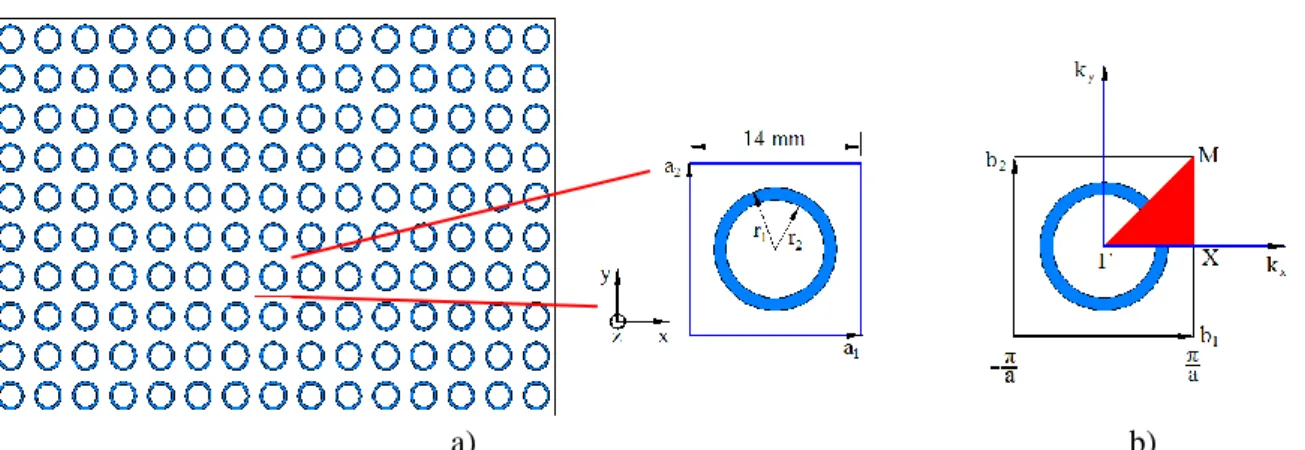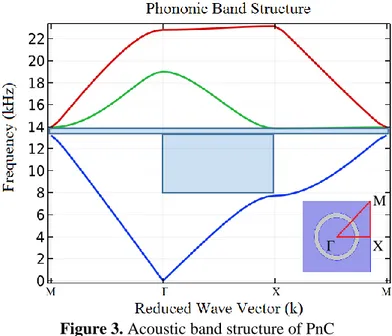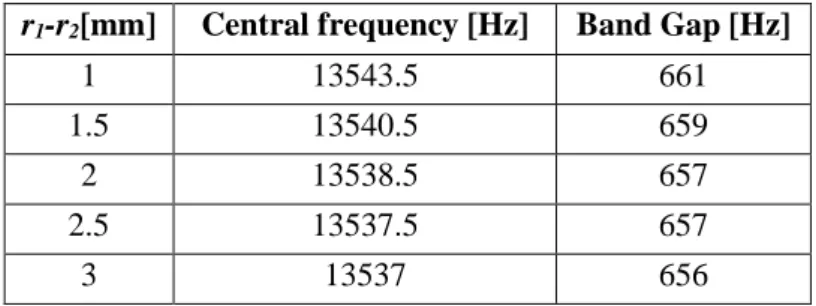Content from this work may be used under the terms of theCreative Commons Attribution 3.0 licence. Any further distribution of this work must maintain attribution to the author(s) and the title of the work, journal citation and DOI.
Published under licence by IOP Publishing Ltd IC-CMTP5
IOP Conf. Series: Materials Science and Engineering 613 (2019) 012018
IOP Publishing doi:10.1088/1757-899X/613/1/012018
1
Band Structure of Phononic Crystal Consist of Hollow
Aluminum Cylinders in Different Media; Finite Element
Analysis
Zafer Ozer1, Mehtap Demir2, Amirullah M. Mamedov 3, 4, Ekmel Ozbay4
1Mersin Vocational High School Electronic and Automation Department, Mersin
University (Turkey)
2Faculty of Engineering, Department of Metallurgy and Material Engineering,
Adiyaman University (Turkey)
3Nanotechnology Research Center (NANOTAM), Bilkent University (Turkey) 4International Scientific Center, Baku State University, Baku (Azerbaijan)
E-mail:zaferozer@mersin.edu.tr
Abstract. In this study, we investigated band structure of a 2D Phononic Crystal (PnC) which
was consist of hollow aluminum cylinders in different media. To validate the finite element predictions, we made a square lattice PnC which has lattice constant a=14mm, outer radius
r1=5mm and inner radius r2=4mm of cylinders. In our experimental measurement, by using a signal generator software, we sent 100 Hz-20kHz sine signal for 5 seconds duration from speaker to the PnC where placed 1m away from. With the help of a microphone, we recorded the sound in front of the PnC (Pin) and backside the PnC (Pout). Then we were converted our recording into frequency domain by standard FFT algorithm, we calculated the Transmission Loss value according to the formula TL = 20*log10 (Pout / Pin) and obtained the experimental Transmission Loss. After experimental validation, we conducted band structure analysis of different combination of the 2D PnC by finite element method.
1. Introduction
Phononic Crystals are periodic structures made of two elastic materials with different mechanical properties. The basic property of PnC is that mechanical (either elastic or acoustic) waves, having frequencies within a specific range, are not able to propagate within the periodic structure. This range of forbidden frequencies is called a phononic band gap. This is analogous to electrons in a crystal, where classical waves propagate in a structure with periodically modulated material parameters [1]. In recent years, many researchers have studied PnC. This is important for applications, such as acoustic filter, noise control, and subwavelength imaging [2, 3]. To acquire wide acoustic band gaps at some desired frequency ranges, several factors are mainly considered, including scatter shapes, filing fraction, shear modulus ratio, mass density ratio, Poisson’s ratio, and lattice structures [4].
In this study, we experimentally demonstrate the existence of complete band gaps in 2D phononic crystal consisting of a square array parallel aluminum cylinders in different media. The Finite Element Method (FEM) is used to calculate the band structure of phononic crystal. Experimental measured data are obtained and compared with the range of frequencies of complete band gaps.
2. Materials and experiments
In the PnC, the propagation of acoustic Bloch waves can be expressed by the acoustic wave equation as in Eq. (1).
IC-CMTP5
IOP Conf. Series: Materials Science and Engineering 613 (2019) 012018
IOP Publishing doi:10.1088/1757-899X/613/1/012018 2 ∇. (𝟏 𝝆∇𝑝) = − 1 𝜌𝑐2[𝜔(𝑘̃)] 2 . 𝑝 (1)
where, c=c(𝑟̃) is longitudinal velocity of acoustic waves inside the PnC,
ρ=ρ(𝑟̃)
is density of the material and 𝑝 = 𝑝𝑘(𝑟̃) is the spatial part of𝑝
𝑘(𝑟̃, 𝑡)
an acoustic Bloch wave within the PnC with wavevector 𝑘̃.In figure 1a the basic vectors of the square lattice are 𝑎1= 𝑎𝑥⃗, 𝑎2 = 𝑎𝑦⃗ and reciprocal lattice vectors in figure 1(b) are 𝑏1=
2𝜋
𝑎 𝑥⃗ , 𝑏2= 2𝜋
𝑎 𝑦⃗. In reciprocal space high symmetry points are; Г=(0,0), X= (𝜋𝑎, 0), M= (𝜋𝑎,𝜋𝑎).
Figure 1. a) Phononic crystal in rectangular lattice in the direct space and unit cell b) high symmetry
points (Г-X-M) irreducible Brillouin Zone in reciprocal space
To obtain the band structure of PnC we applied Floquet periodic conditions edges of the unit cell in figure 1(a). The obtained acoustic band structure was plotted along the M–Г–X–M path for the two dimensional (2D) PnC as seen in fig. 2.
For validating the attenuation of acoustic waves as seen in band structure of unit cell, we conclude a measurement setup by finite array of PnC as seen in fig 1(a) and we designed the finite array as seen in fig. 2. In finite array FEM analysis, we applied Symmetry Boundary Conditions upper and lower edges, we assumed Perfectly Matched Layer left and right ends, and we applied 1 Pa pressure to the back pressure field in x direction as seen in fig. 2. In fig.2 the points A and B are Pin and Pout observation points in following TL formula.
Figure 2. Boundary conditions of finite array FEM model
The experimental setup consists of 150 aluminum cylinders with an internal diameter of 8 mm an external diameter of 10 mm and length of 29.5 mm in the form of square lattice with a lattice constant a = 14 mm were placed in the holes on the fiber substrate in a 10x15 array.
In our experimental study, we placed a speaker 1 m away from the PnC and we sent a sound signal from 100 Hz to 20000 Hz on to the PnC for 5 seconds. With the microphone we placed behind the PnC, we recorded the sound signal to the computer via an external sound card and converted it to the frequency domain with the standard FFT algorithm. Then we obtained the experimental transmission loss according to the formula TL = 20 * log10 (Pout / Pin) where Pin the data obtained from the microphone that we placed on the front side of the PnC and Pout the data we obtained from the microphone which we placed behind the PnC.
IC-CMTP5
IOP Conf. Series: Materials Science and Engineering 613 (2019) 012018
IOP Publishing doi:10.1088/1757-899X/613/1/012018
3
Furthermore, we performed parametric scanning to examine the effect of the thickness of the aluminum cylinder on the band structure by FEM. The band structure of PnC is calculated, with the geometrical parameters r1 = 5 mm, r2 = 4, 3.5, 3, 2.5 mm where r1 and r2 are the outer and inner radius of the hollow cylinder of large size, respectively.
3. Results and discussions
Obtained acoustic band structure in Brillouin zone of the square lattice was plotted along the M–Г–X– M path for the two dimensional (2D) PnC as seen in fig. 3, the narrow full band observed in the dispersion curves between 13.2-13.8 kHz and a partial band between 8-14 kHz in Γ-X direction.
Figure 3. Acoustic band structure of PnC
In order to compare the band structure obtained by FEM and the sound attenuation obtained by PnC, transmission loss was obtained numerically with finite structure seen in Fig. 2 by FEM and experimental measurement. Fig.3 shows the numerical and experimental measurement results.
Simulation Experimental
a) b)
Figure 4. Transmission Loss of finite array a) FEM analysis b) measurement Г X
IC-CMTP5
IOP Conf. Series: Materials Science and Engineering 613 (2019) 012018
IOP Publishing doi:10.1088/1757-899X/613/1/012018
4
According to the results of the transmission loss we obtained by FEM and experimental measurement, the sound level decreased between 8-14 kHz as in the band structure and the results are compatible.
We investigated the effect of wall thickness (r1-r2) on the band gap using FEM. as shown in table 1, the center frequency and bandwidth are reduced when the wall thickness is increased.
Table 1. Band relation with wall thickness r1-r2[mm] Central frequency [Hz] Band Gap [Hz]
1 13543.5 661 1.5 13540.5 659 2 13538.5 657 2.5 13537.5 657 3 13537 656 4. Conclusions
In the present paper, a PnC with hollow cylinder columns was presented and investigated. The band structure was calculated using the finite element method. The band gap and frequency can be tuned by changing the inner radius of the hollow cylinders. It could be based on the design of the elastic acoustic wave guides that transmit at tunable frequencies using proposed structures. We have also shown the band structure of the 2D PnC that is compatible with the transmission losses obtained by numerical and experimental measurement.
References
[1] P Deymier 2013 Acoustic Metamaterials and Phononic Crystals Springer-Verlag Berlin Heidelberg
[2] M S Kushwaha, P Halevi 1996 Applied Physics Letters 69 (1) 31
https://aip.scitation.org/doi/10.1063/1.118108
[3] A Sukhovich, B Merheb, K Muralidharan, J O Vasseur, Y Pennec, P A Deymier, J H Page 2009
Physical Review Letters 102 (15) 154301 https://doi.org/10.1103/PhysRevLett.102.154301
[4] C He, H Zhao, R Wei; B Wu 2010 Frontiers of Mechanical Engineering in China 5 (4) 450


